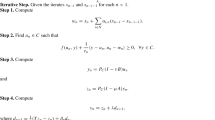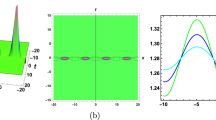Abstract
We propose and analyze an efficient spectral-Galerkin approximation for the Maxwell transmission eigenvalue problem in spherical geometry. Using a vector spherical harmonic expansion, we reduce the problem to a sequence of equivalent one-dimensional TE and TM modes that can be solved individually in parallel. For the TE mode, we derive associated generalized eigenvalue problems and corresponding pole conditions. Then we introduce weighted Sobolev spaces based on the pole condition and prove error estimates for the generalized eigenvalue problem. The TM mode is a coupled system with four unknown functions, which is challenging for numerical calculation. To handle it, we design an effective algorithm using Legendre-type vector basis functions. Finally, we provide some numerical experiments to validate our theoretical results and demonstrate the efficiency of the algorithms.








Similar content being viewed by others
References
Cakoni, F., Colton, D.: Qualitative Methods in Inverse Scattering Theory. Springer, Berlin, Heidelberg (2006)
Cakoni, F., Colton, D., Monk, P.: The Linear Sampling Method in Inverse Electromagnetic Scattering. SIAM, Philadelphia (2011)
SUN, J., XU, L.: Computation of Maxwells transmission eigenvalues and its applications in inverse medium problems. Inverse Probl. 29(10), 104013 (2013)
Cakoni, F., Colton, D., Monk, P.: On the use of transmission eigenvalues to estimate the index of refraction from far field data. Inverse Probl. 23(2), 507–522 (2017)
Cakoni, F., Colton, D., Monk, P., Sun, J.: The inverse electromagnetic scattering problem for anisotropic media. Inverse Probl. 26, 074004 (2010)
An, J., Shen, J.: Efficient spectral methods for transmission eigenvalues and estimation of the index of refraction. J. Math. Study 1(1), 1–20 (2014)
Haddar, H.: The interior transmission problem for anisotropic maxwells equations and its applications to the inverse problem. Math. Method Appl. Sci. 27(18), 2111–2129 (2004)
Sun, J.: Estimation of transmission eigenvalues and the index of refraction from Cauchy data. Inverse Probl. 27, 015009 (1998)
CAKONI, F., COLTON, D.: On the determination of dirichlet or transmission eigenvalues from far field data. Comptes Rendus Mathematique 348(7–8), 379C383 (2010)
Monk, P., Sun, J.: Finite element methods for Maxwell’s transmission eigenvalues. SIAM J. Sci. Comput. 34(3), B247–B264 (2012)
Huang, T.M., Huang, W.Q., Lin, W.W.: A robust numerical algorithm for computing Maxwell’s transmission eigenvalue problems. SIAM J. Sci. Comput. 37(5), A2403–A2423 (2015)
Cakoni, F., Haddar, H.: On the existence of transmission eigenvalues in an inhomogeneous medium. Appl. Anal. 88(4), 475–493 (2009)
Ma, L., Shen, J., Wang, L.L.: Spectral approximation of time-harmonic Maxwell equations in three-dimensional exterior domains. Int. J. Numer. Anal. Mod. 12(2), 1–18 (2015)
Hill, E.L.: The theory of vector spherical harmonics. Am. J. Phys. 22, 211–214 (1954)
Hagstrom, T., Lau, S.: Radiation boundary conditions for Maxwells equations: A review of accurate time-domain formulations. J. Comput. Math. 25(3), 305–336 (2007)
Barrera, R.G., Estevez, G.A., Giraldo, J.: Vector spherical harmonics and their application to magnetostatics. Eur. J. Phys. 6, 287 (1985)
SHEN, J., TANG, T., WANG, L.L.: Spectral Methods: Algorithms, Analysis and Applications. Springer, Berlin (2011)
Min, M.S., Gottlieb, D.: On the convergence of the Fourier approximation for eigenvalues and eigenfunctions of discontinuous problems. SIAM J. Numer. Anal. 40(6), 2254–2269 (2003)
Shen, J., Tang, T.: Spectral and High-order Methods with Applications. Science Press, Beijing (2006)
Sun, J.: Iterative methods for transmission eigenvalues. SIAM J. Numer. Anal. 49, 1860–1874 (2011)
Golub, G.H., van Loan, C.F.: Matrix Computations. The John Hopkins University Press, Baltimore (1989)
Kwan, Y., Shen, J.: An efficient direct parallel elliptic solver by the spectral element method. J. Comput. Phys. 225, 1721–1735 (2007)
Author information
Authors and Affiliations
Corresponding author
Additional information
This work was supported in part by the National Natural Science Foundation of China (Nos. 11661022, 11471031, 91430216), NASF U1530401, and the US National Science Foundation Grant DMS-1419040.
Appendices
Appendix A: Proof of Theorem 4
Let \(u_*(t)=\frac{1}{4}(t+1)(1-t)^2\partial _tu(-1)\) for \(\forall u\in H_{0,\omega ,l}^2(I)\). By construction, we have \(\partial _t^k(u-u_*)(\pm 1)=0,(k=0,1).\) If \(u\in H_{\omega ^{-2,-2},l}^s(I)\) , then we have \(u-u_*\in H_{\omega ^{-2,-2},*}^s(I)\). In fact, from Hardy inequality (cf. B 8.8 in [17]) we have
Thus, we can derive that
Since
then we have
Similarly, we can derive that \(\int _I\omega ^{1,1}(\partial _t^3u_*)^2dt=3(\partial _tu(-1))^2\lesssim \int _I(\partial ^2_tu)^2dt.\) Thus we have
For \(k>3\), we have
Thus, \(u-u_*\in H_{\omega ^{-2,-2},*}^s(I)\) and we can define
Then by Lemma 4.5 we can obtain
Together with (A.1), (A.2) and (A.3) we can get desired results. \(\square \)
Appendix B: Proof of Theorem 5
For any \(v\in E_{1,m}\) it can be represented by \(v=\sum _{i=1}^m\mu _iu_l^i\), we then have
From Cauchy–Schwarz inequality we have
From Hardy inequality (cf. B 8.6 in [17]) we have
Then from \(\hbox {Poincar}\acute{e}\) inequality we can obtain
From the property of orthogonal project (4.34) and continuity of \(A_{\tau _l}(u,v)\) in Theorem 1 we can derive that
Since
Rights and permissions
About this article
Cite this article
An, J., Zhang, Z. An Efficient Spectral-Galerkin Approximation and Error Analysis for Maxwell Transmission Eigenvalue Problems in Spherical Geometries. J Sci Comput 75, 157–181 (2018). https://doi.org/10.1007/s10915-017-0528-2
Received:
Revised:
Accepted:
Published:
Issue Date:
DOI: https://doi.org/10.1007/s10915-017-0528-2




